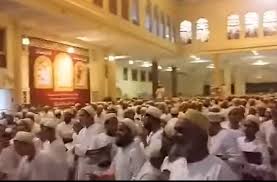Mumbai, Jun 23: Days after Pakistan hammered a blundering India by 180 runs to lift the ICC Champions Trophy, at The Oval, a video showing hundreds of people donned in white attire with skull caps on their heads celebrating men in green’s victory has created a row on social media.
 The online ‘swayamsevaks’ of Sangh Parivar went on to claim that the video was shot in a mosque in Mumbai's Mira road where according to them people celebrated Pakistan's triumph.
The online ‘swayamsevaks’ of Sangh Parivar went on to claim that the video was shot in a mosque in Mumbai's Mira road where according to them people celebrated Pakistan's triumph.
The video, which went viral on social media, especially on Twitter and Whatsapp, instigated much hate speech and jingoism, with some resorting to use derogatory remarks against Indian Muslims.
However, during investigation it was ascertained that no Mumbai mosque ever glorified India's defeat. "The premises or place shown in the video cannot be a mosque because TV sets will not be installed inside places of prayer," said a senior police officer in Mumbai.
When the video was monitored closely, it was established that the clip was not shot in India. Moreover, as per the clip people cheering for Pakistan were watching the match aired on PTV sports, the official broadcaster of ICC Champions Trophy in Pakistan.
The fact is that the video was shot in Pakistan where people were supporting and cheering for their team’s victory. It's a celebration of Pakistan's win by Pakistanis inside Pakistan and not by Indians as claimed by the hatemongers on social media.
When the reality came to light, the fun-mongers on social media started accusing Saffronists of granting Indian nationality to Pakistanis. “Funny Sanghis. They call Indians as Pakistanis and Pakistanis as Indians,” tweeted an Indian youth.




Comments
Saffronists may prove in future to be more deadly than ISIS.
Add new comment